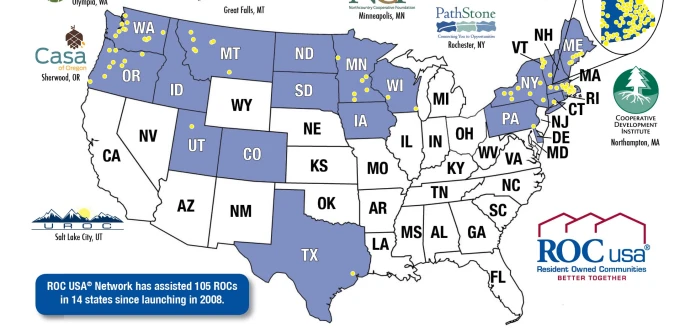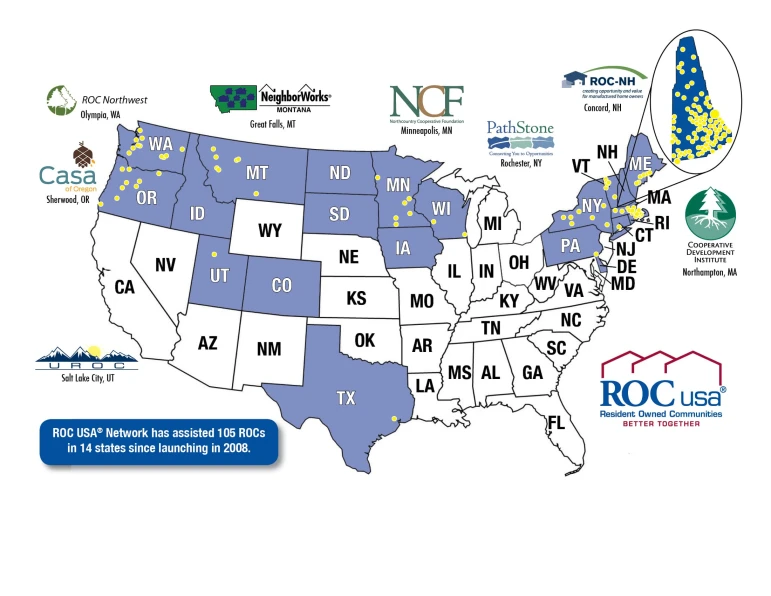
Last week I heard from an old colleague on LinkedIn. She asked how I and ROC USA® were doing.
I was happy to report that I am personally well – it’s nice when someone cares enough to ask – and that ROC USA is making good progress as we approach our 9th birthday in May. She was involved with us 10 years ago but hasn’t followed us much since.
I let her know that ROC USA® Network and ROC USA® Capital set records in 2016. That feels noteworthy.
ROC USA Network supported 17 new Resident Owned Communities and preserved 1,380 homes in seven states (Washington, Wisconsin, New York, Vermont, Massachusetts, New Hampshire and Maine) in 2016. That’s more communities and homes preserved in any single year in the 32-year history of limited equity MHC co-ops! 
ROC USA Network now serves more than 12,150 homeowners and 196 ROCs in 14 states from coast to coast.
ROC USA Capital also set a record with $34M in total lending to 10 ROCs. ROCs are not viable without access to financing so raising capital and lending is vital to our mission.
I shared the study showing that ROCs after just five years of ownership have rents between market rate and as much as 17% below market. They’re also being prudently managed with respect to reserves and finances. The average annual rent increase in ROCs is just under 1%, or just under $4 per year on average. There’s no one comparable statistic for commercial MHCs, but in my experience, I commonly see annual increases of $10 – $20.
Growth and impact are good, of course. We set out to make resident ownership viable and successful across the country and we’re making good progress. But it isn’t just about growth, everyone is also interested in work and innovation to make resident ownership successful and to bring economic benefit to ROC members.
There are numerous ROCs undertaking major improvement projects this year. Two ROCs in New York supported by PathStone, the CTAP in Western New York, will invest over $4M in water, sewer, roads and electric improvements. Both The Woodlands Community and Kayadeross Acres were once considered “the MHCs to move into” in their regions and both had fallen into disrepair before their big projects.
I am also seeing the first community solar project under way at a ROC. Imagine using excess land to generate income and cost savings. When it goes live, we’ll write about it.
There’s innovation with new energy-efficient homes going into ROCs, and new sources of home-only financing becoming available in ROCs. Better rates and lower utility costs really matter to household budgets.
There is increasing access to home rehab resources – like USDA’s 504 program. Last week, CASA of Oregon helped two ROC members get access to the grant/loan program, a first for any ROC member in Oregon. Four CTAP organizations are also working to get USDA 502 loans for new energy efficient homes in Vermont, New Hampshire, Minnesota and Oregon ROCs. And, ROC-NH is leveraging the Federal Home Loan Bank system for home rehab funding in a few ROCs, too.
We have several ROCs participating in our Digital Bridge project – where ROC USA Network and CTAPs are helping ROC leaders get connected to the internet and leveraging technology to improve operations and peer learning. We are really excited about getting all ROCs online and connected to resources.
I had all of that inside of me, just waiting for someone to ask the question. Writing all of that to her gave me great pride in the community leaders, CTAPs and national staff that are involved in growing as a Network and adding Member Benefits along the way. We won’t remake the world, but we can remake hundreds of neighborhoods. Better Together.
